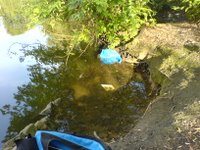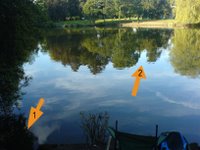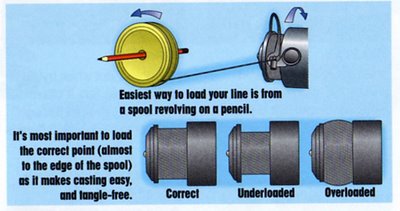The forecast for today was that it would be a nice, warm and sunny day. I woke up this morning only to find that it was absolutely pouring it down with rain, complete with lightning and thunder. I decided that I didn't want to be locked up inside the house so I made a little visit to Fishing Republic in Swinton. It is a relatively new tackle store (it used to be a warehouse for a garage). It was the largest tackle store I have ever seen and the variety of the products was immense. However, it was a shame to find that they only dealt in coarse tackle. They did have a large stock of Dynamite Baits Marine Halibut Pellets and the Silver X Groundbait Feeder range which I have been looking for ages. It cost me £6 in all. On the way home the weather cleared up - the dark clouds broke away to reveal a beautiful blue sky and shining sun. This cheered me up because I knew what this meant - it will soon be time to go fishing.

Since it's Ramadan and I was fasting, I decided to pay a visit to Alexandra Park, which is literally down the road and only a 10 minute walk away. As you can see, it has a rather large lake. However, over the years it has been continuously polluted by people throwing in carrier bags after feeding the birds etc. You will even find bags of concrete in the water!!! As a result of this, fishing at this venue can be rather difficult and tedious. If your float goes under, there is a chance that you may have hooked a carrier bag or some other item that shouldn't be in there (Wellingtons anyone?).
The pollution that I have mentioned can be shown by the p

icture on the right. Unforunately, there is no part of the lake which is litter free, so I had to be careful when fishing my chosen swim. It will be obvious if you haven't actually hooked a fish - if you have succeded in hooking a fish, you will fell knocks and taps on the rod as the fish tries to struggle and swim away. If these knock are absent, but you still have some resistance and tension on the line, it is very likely that you have hooked a carrier bag or log. If you find yourself in this situation, NEVER quickly reel in the line, as this will certainly result in your line snapping. Instead, apply reasonable constant pressure on the line and very slowly reel the line in. That's my lesson in avoiding line snaps done. Let's get on with the fishing.

I only had one hour to catch something, so I quickly set to work. I decided to attack two swims today which are marked on the photo:
1. Overhanging trees and bushes are great habitats for fish. The branches and leaves offer protection to the fish from predators. You will often find insects in these areas which are a source of food for the fish. I will be using the pole for this swim.
2. Open water will also hold fish. There is hardly any weed groth in this lake, but carrier bags, boots and other items which have been thrown in act as great habitats for fish. I will use a 1.8m Shimano lure rod for this swim.
You may be asking yourself why I'm using a small lure rod. The simple answer is that there are low lying trees just above the peg. If I were to use a 12ft float rod, this would certainly result in the line getting caught in the branches. On either side of the peg there were bushes which only gave me about a 9ft circle to work within.
I threw in a hadfull of white and red maggots into the swim in order to switch the fish into feeding mode. Within 10 minutes I could already see bubbles appearing in both swims.
For my pole, I was using a 4x12 pole float attached to 4lb mainline. A 2lb hooklength (approximately 12 inches in length with a size 16 hook) was attached using a loop-to-loop.The depth I was fishing at was about a foot. For my float rod, I used a 1 1/2 AA insert waggler with 4lb mainline and 3lb hooklength with a size 16 hook. The depth for this was 1.5ft Both hooks were baited with a red and white maggot combination.
I set my pole float into my chosen swim just underneath an overhanging tree. I cast my insert waggler into the swim straight ahead of me which was about 15 yards away. Straight away my insert float dipped right under, but I was too slow to react (I'm a pretty big bloke lol). This kept going on for about 20 minutes until I was finally into a fish. It was a decent sized roach with beautiful orange fins weighing about 8oz. After unhooking the fish and returning it to the water, Billy came round to have a look at what I was doing. Alexandra Park was the first venue I fished when I took up fishing, and on that day I met Billy who, after about 15 years of having abandoned fishing, decided to take it up again. He was a great help and helped me immensely with my fishing. We started to chat for a while and I then realized that my pole float went right under! I quickly ran to my pole rod and lifted the rig to set the hook. It was a small perch but the bugger got away!!!
Oh well, at least I caught a fish. Catching one fish is better than catching none. On that bombshell, I had to leave - it was getting dark and it was time to open my fast.
 Don't be inclined to plumb the depth in one area, though. You will often find fish at dropoffs (this is where the depth of the water changes significantly, such as underwater cliffs and undercut banks etc.) So make sure to plumb the depth all around your swim to create a picture of what the bottom of the lake/river/canal is like. The time invested in this will be worthwhile - a person who has not plumbed the depth will often go home having caught nothing.
Don't be inclined to plumb the depth in one area, though. You will often find fish at dropoffs (this is where the depth of the water changes significantly, such as underwater cliffs and undercut banks etc.) So make sure to plumb the depth all around your swim to create a picture of what the bottom of the lake/river/canal is like. The time invested in this will be worthwhile - a person who has not plumbed the depth will often go home having caught nothing.











